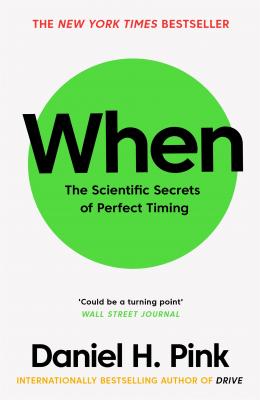When. Daniel H. Pink
Читать онлайн.| Название | When |
|---|---|
| Автор произведения | Daniel H. Pink |
| Жанр | Банковское дело |
| Серия | |
| Издательство | Банковское дело |
| Год выпуска | 0 |
| isbn | 9781782119906 |
Daniel H. Pink is the author of several books, including the New York Times bestselling Drive, To Sell is Human and A Whole New Mind. His books have been translated into 35 languages and have sold more than 2 million copies worldwide. He lives in Washington D.C. with his wife and children. danpink.com
Also by Daniel H. Pink
Free Agent Nation
A Whole New Mind
The Adventures of Johnny Bunko
Drive
To Sell Is Human
When
The SCIENTIFIC SECRETSof PERFECT TIMING
Daniel H. Pink
Published in Great Britain in 2018 by Canongate Books Ltd, 14 High Street, Edinburgh EH1 1TE
This digital edition first published in 2017 by Canongate Books
© Daniel H. Pink, 2018
The moral right of the author has been asserted
First published in 2018 by Riverhead Books, an imprint of Penguin Group (USA)
Inc., 375 Hudson Street, New York, NY 100014, USA
British Library Cataloguing-in-Publication Data A catalogue record for this book is available on request from the British Library
ISBN 978 1 78211 991 3
Export ISBN 978 1 78211 989 0
eISBN 978 1 78211 990 6
CONTENTS
Introduction: Captain Turner’s Decision
1. The Hidden Pattern of Everyday Life
“A growing body of science makes it clear: Breaks are not a sign of sloth but a sign of strength.”
PART TWO. BEGINNINGS, ENDINGS, AND IN BETWEEN
3. Beginnings: Starting Right, Starting Again, and Starting Together
“Most of us have harbored a sense that beginnings are significant. Now the science of timing has shown that they’re even more powerful than we suspected. Beginnings stay with us far longer than we know; their effects linger to the end.”
4. Midpoints: What Hanukkah Candles and Midlife Malaise Can Teach Us About Motivation
“When we reach a midpoint, sometimes we slump, but other times we jump. A mental siren alerts us that we’ve squandered half of our time.”
5. Endings: Marathons, Chocolates, and the Power of Poignancy
“Yet, when endings become salient—whenever we enter an act three of any kind—we sharpen our existential red pencils and scratch out anyone or anything nonessential.”
PART THREE. SYNCHING AND THINKING
6. Synching Fast and Slow: The Secrets of Group Timing
“Synchronizing makes us feel good—and feeling good helps a group’s wheels turn more smoothly. Coordinating with others also makes us do good—and doing good enhances synchronization.”
7. Thinking in Tenses: A Few Final Words
“Most of the world’s languages mark verbs with time using tenses— especially past, present, and future—to convey meaning and reveal thinking. Nearly every phrase we utter is tinged with time.”
Time isn’t the main thing. It’s the only thing.
—MILES DAVIS
INTRODUCTION:
CAPTAIN TURNER’S DECISION
Half past noon on Saturday, May 1, 1915, a luxury ocean liner pulled away from Pier 54 on the Manhattan side of the Hudson River and set off for Liverpool, England. Some of the 1,959 passengers and crew aboard the enormous British ship no doubt felt a bit queasy—though less from the tides than from the times.
Great Britain was at war with Germany, World War I having broken out the previous summer. Germany had recently declared the waters adjacent to the British Isles, through which this ship had to pass, a war zone. In the weeks before the scheduled departure, the German embassy in the United States even placed ads in American newspapers warning prospective passengers that those who entered those waters “on ships of Great Britain or her allies do so at their own risk.”1
Yet only a few passengers canceled their trips. After all, this liner had made more than two hundred transatlantic crossings without incident. It was one of the largest and fastest passenger ships in the world, equipped with a wireless telegraph and well stocked with lifeboats (thanks in part to lessons from the Titanic, which had gone down three years earlier). And, perhaps most important, in charge of the ship was Captain William Thomas Turner, one of the most seasoned seamen in the industry—a gruff fifty-eight-year-old with a career full of accolades and “the physique of a bank safe.”2
The ship traversed the Atlantic Ocean for five uneventful days. But on May 6, as the hulking vessel pushed toward the coast of Ireland, Turner received word that German submarines, or U-boats, were roaming the area. He soon left the captain’s deck and stationed himself on the bridge in order to scan the horizon and be ready to make swift decisions.
On Friday morning, May 7, with the liner now just one hundred miles from the coast, a thick fog settled in, so Turner reduced the ship’s speed from twenty-one knots to fifteen knots. By noon, though, the fog had lifted, and Turner could spy the shoreline in the distance. The skies were clear. The seas were calm.
However,
